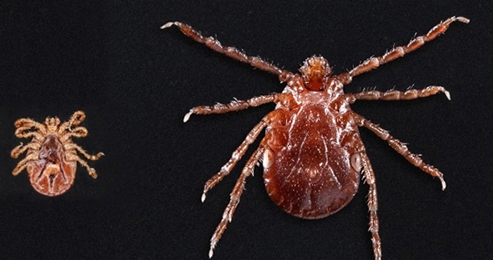
Ticks are often seen as a nuisance of summer hikes and camping trips, but one invasive species has experts on edge. Since its discovery in New Jersey in 2017 by public health officials in Hunterdon County, NJ, the Asian longhorned tick has spread to more than 20 states, and it’s not slowing down. What makes it unusual is its ability to reproduce without mating, allowing populations to explode from just a single female.
This isn’t only a problem for farmers and wildlife. The tick is capable of carrying infections that threaten human health, raising urgent questions about how we protect ourselves, our communities, and even our connection to the environment as climate conditions shift.
What Is the Asian Longhorned Tick and Why Are Experts Concerned?
The Asian longhorned tick (Haemaphysalis longicornis) has now been detected in states including Maine, New York, Virginia, Tennessee, and Arkansas.
This species is especially difficult to control because females can reproduce without mating, laying thousands of eggs at once. That unique ability means infestations can build rapidly and spread over large areas.
The tick feeds on a wide variety of hosts, from deer and livestock to pets and people. This makes it both a public health issue and a threat to agriculture. In regions where the tick is well established, livestock have suffered from blood loss, reduced milk production, and increased disease risk.
The Health Risks Tied to This Invasive Tick
The greatest concern is the tick’s ability to transmit ehrlichiosis, a bacterial infection that can cause fever, chills, muscle aches, fatigue, and headaches. Severe cases may progress to breathing difficulties or organ complications, and hospitalization may be required if treatment is delayed.
In its native range, the Asian longhorned tick has also been linked to other viruses and bacteria, some of them potentially fatal. While not all of these pathogens have been confirmed in U.S. populations, research shows that the risk exists as the tick adapts to new environments.
Because ehrlichiosis is less widely known than Lyme disease or Rocky Mountain spotted fever, it may be overlooked by both patients and doctors. Delayed diagnosis increases the risk of complications, making it essential to take unexplained fevers or flu-like symptoms seriously after spending time outdoors.
How Climate Change Is Driving Tick Expansion
Rising average temperatures and shorter winters are allowing ticks to survive in areas once considered too cold. Longer warm seasons extend their activity window, giving them more opportunities to feed and reproduce.
Public health officials emphasize that this trend isn’t unique to the longhorned tick. Other disease-carrying ticks are also appearing in new places. But the longhorned tick’s ability to multiply rapidly without mating makes it a unique and pressing concern.
In an interview with NBC News, Goudarz Molaei, the director of the lab’s tick-testing program said the situation is a storm brewing. “Climate change eventually will almost eliminate winter in our region. And this tick, like other tick species, will be active year-round.”, she said.
Shifts in wildlife movement also support their spread. Deers, a common host, are appearing in new regions as habitats change, carrying ticks with them.
Protecting Yourself And Your Family From Tick Bites
Clothing and Personal Protection
- Wear long sleeves and pants in grassy or wooded areas.
- Tuck pants into socks to block tick access.
- Choose light-colored clothing to make ticks easier to spot.
- Use repellents with DEET, picaridin, or oil of lemon eucalyptus.
Natural Repellent Options you can try are essential oils such as eucalyptus, citronella, neem, and cedarwood, they have tick-repelling properties but require more frequent application than chemical repellents. They are a good plant-based alternative.
After-Activity Checks
- Perform full-body checks after being outdoors.
- Shower soon after returning inside.
- Dry clothes on high heat to kill ticks that may have latched on.
Protecting Pets
Pets often bring ticks indoors. Use veterinarian-recommended preventives and check their fur regularly, especially after walks.
Yard Management
- Keep grass trimmed and remove brush where ticks hide.
- Use gravel or woodchip barriers between lawns and wooded areas.
- Discourage deer with fencing or deer-resistant landscaping.
Farmers and Communities
For farmers, the tick is more than a minor pest—it can cause significant losses. Heavy infestations in livestock may lead to anemia, reduced productivity, and greater vulnerability to disease. Monitoring animals and working with veterinarians on prevention are critical steps.
Communities also benefit from awareness. Local surveillance programs, early reporting of infestations, and neighborhood education campaigns can help track and slow the tick’s spread.
Spiritual Consciousness Associated With the Longhorned Tick
The spread of the Asian longhorned tick is not just a medical challenge but also a reminder of our deep connection with nature. When ecosystems shift, human health shifts too.
Tick-borne illness doesn’t only affect the body. Symptoms like fatigue or brain fog can disrupt emotional balance, drain mental clarity, and weaken intuition. Protecting physical health safeguards these subtler aspects of well-being, helping us stay centered and connected.
Awareness of threats like the invasive tick can also deepen spiritual consciousness. It encourages us to:
- Listen to the body’s signals and respect early warning signs.
- Practice calm and mindfulness even when external conditions feel uncertain.
- Rebuild harmony with nature, living in ways that support balanced ecosystems.
The spread of the Asian longhorned tick is a reminder that health challenges don’t always arrive with loud warnings. Sometimes they come quietly, carried on the back of a deer, a family pet, or even a breeze across tall grass. What seems like a minor nuisance can carry consequences that affect not just physical health, but also emotional balance and the way we connect with the natural world.
Staying vigilant doesn’t mean living in fear, it means living with awareness. By protecting your body with simple precautions, caring for your pets and outdoor spaces, and staying informed about local health updates, you create a buffer against disease while strengthening your relationship with the environment.
The tick’s rapid spread shows how closely our well-being is tied to the health of our ecosystems. By respecting that connection and choosing preventive steps each time you head outdoors, you safeguard more than your physical health, you protect your sense of clarity, energy, and balance in everyday life.
When we seeing health as a whole—body, mind, and spirit—we strengthen not only immunity but also our ability to live with clarity and connection.
Featured Image from Indiana Department of Health











Leave a Reply